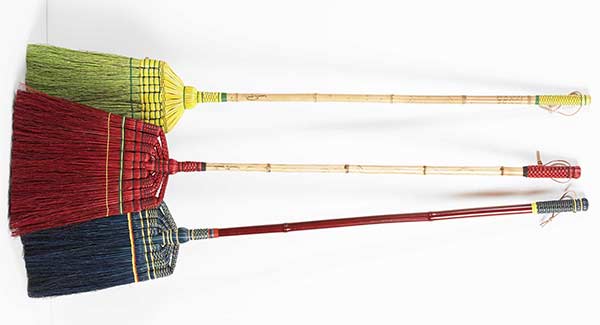

Outfitting and camping stores often carry nylon cord for anchoring duck decoys, and local craft stores will have macramé cord, which also works well. You can also use mason’s line, although finding appealing colors may be challenging. I recommend nylon cord for tying brooms because it’s sturdy enough for the job and comes in attractive colors. Sharpen one end with a hatchet or a knife, and drill a hole just above the taper you created this will be for anchoring the string you’ll use to attach the broom corn. After a stick has cured and seems structurally sound, it’ll be ready to prepare for a broom. If any shrinkage, cracking, or peeling occurs during the curing period, reject those sticks. After I collect my handles, I cut them to length - 18 inches for a hearth broom - and then cure them for at least six months. You can order commercial dowel handles from a supplier, but I prefer to go the rustic route and use a stick with the bark left on. While the broom corn is soaking, you can prepare the handle. Next, submerge the cut stalks in a bucket of hot water for at least 15 minutes. Straight, unblemished material looks best on the outer layer of the finished broom. Split the stalks on the pieces for the outer layer, removing half the material. If the material is too short, you can use it for a whisk broom later.Ĭut off most of the stalk on the heads for the inner layers, leaving a few inches, and trim the stalks for the outer layer to six inches. If the bristles are past the tips of your fingers, it’s a keeper.

Put the corn’s “knuckle” (the point between the tassel and the stalk) at your elbow, with the tassel pointing toward your fingers. Measure each head with a cubit - the distance from your elbow to the tip of your longest finger. To make a hearth broom, you’ll need about 28 heads of broom corn for the inside and 17 heads for the outside, with the seeds removed. 2 to 3 pounds of broom corn (about 45 heads).You should be able to find the other materials and tools at local craft and hardware stores.

If not, consider ordering it from a supplier, such as Caddy Supply Company. If you have a green thumb, growing your own broom corn can be part of your broom-making journey (see All About Growing Sorghum).
BROOM PICTURES HOW TO
You can also use other natural materials, but in this article, I’ll focus on how to make a traditional corn hearth broom. That tassel is what you’ll need for making brooms. Upon close examination, however, you’ll notice there are no cobs along the stalk - just a large tassel on top with a swollen knuckle at the intersection with the stalk. Broom corn is an annual and looks like sweet corn from a distance. I’ve been making brooms for several years, and one of the most common questions I hear while demonstrating my craft is, “What plant material is used for the bristles?” The answer is broom corn ( Sorghum bicolor, also called Sorghum vulgare), which is a variant of the sorghum grown for sorghum molasses. Sweeping with a handmade broom can connect you with the long history of brooms made out of natural materials, from improvised brooms crafted from broken branches to rural artworks featuring decorative stitches. Get a list of all the handmade broom making supplies you will need! Check out these easy to follow homemade broom making instructions.


 0 kommentar(er)
0 kommentar(er)
